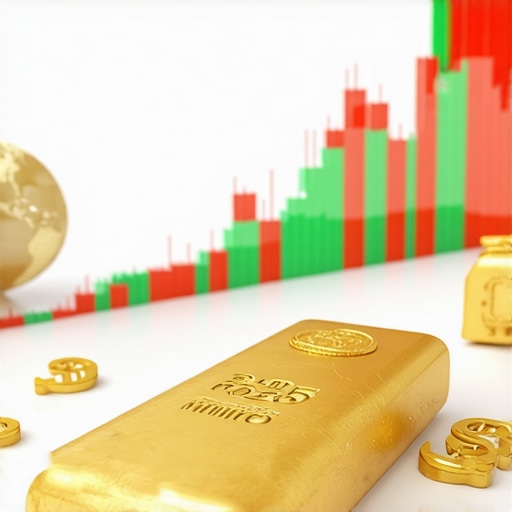Unraveling the Complexities of Gold Demand in 2025: An Expert Perspective
As we stand on the cusp of 2025, the gold market emerges as a sophisticated tapestry woven from multifaceted industry and consumer demand factors. Recognized for its dual role as a hedge against economic volatility and a vital industrial resource, gold’s demand trajectory in 2025 warrants a nuanced analysis rooted in supply chain dynamics, technological innovation, and geopolitical influences.
Industry Demand: Navigating Supply Chain Resilience and Technological Integration
How are industrial applications shaping gold demand amidst supply chain disruptions?
Industrial sectors, particularly electronics, aerospace, and medical devices, are increasingly integrating gold due to its exceptional conductivity and corrosion resistance. The ongoing supply chain disruptions, driven by geopolitical tensions and logistical bottlenecks, have prompted industries to innovate in recycling and sourcing strategies. For instance, the burgeoning demand for high-precision electronics amplifies gold’s role, with supply-side constraints potentially elevating prices. To explore related investment avenues, consider examining gold stocks and mining shares for diversification in 2025.
Consumer Demand: Emerging Trends in Jewelry and Digital Asset Adoption
Consumer demand remains robust, especially within jewelry and investment segments. The resurgence of luxury jewelry, driven by millennial and Gen Z consumers, is complemented by an increasing interest in digital gold and blockchain-based assets. These trends reflect broader shifts towards digital transformation and sustainable sourcing. Notably, the demand for high-quality gold coins and bullion persists as a safe-haven investment amid volatile markets, underscoring the importance of understanding top gold coins and bullion options for 2025.
Supply-Demand Equilibrium: The Role of Central Banks and Global Markets
Central banks continue to be pivotal players, with their gold purchase strategies influencing price trends. According to recent reports from the World Gold Council, central banks have increased their gold reserves, signaling a shift towards diversification and economic resilience. Meanwhile, market-driven factors such as ETF flows and investor sentiment contribute to price volatility. Understanding how central bank purchases will shape gold prices in 2025 is crucial for strategic positioning.
What are the implications of evolving supply and demand dynamics for long-term investors?
Long-term investors should consider how these supply-demand shifts impact gold’s role as a portfolio hedge. Diversification through gold-related assets, including ETFs and mining stocks, remains a prudent approach. For comprehensive strategies, see analyses of gold supply and demand in 2025.
Engaging with these advanced insights, investors and industry stakeholders can better navigate the intricate landscape of gold demand in 2025, leveraging expert knowledge to optimize investment outcomes.
Decoding the Impact of Digital Transformation on Gold Market Dynamics in 2025
As digital assets continue to reshape the investment landscape, understanding how blockchain technology and digital gold are influencing demand becomes crucial. These innovations are not only changing consumer behavior but also challenging traditional notions of gold as a physical asset. Experts suggest that this technological shift could lead to increased liquidity, broader accessibility, and new investment strategies. To explore these emerging opportunities, consider reviewing guides on investing in gold for retirement in 2025.
How Will Geopolitical Shifts Reconfigure Gold’s Role in Global Economics?
Geopolitical tensions, trade disputes, and regional conflicts are continuously shaping the demand for gold as a safe-haven asset. Recent analyses indicate that shifts in global power dynamics, especially in regions like the Middle East and Asia, could significantly influence gold reserves and trading patterns. For instance, countries diversifying their reserves away from the US dollar may increase their gold holdings, impacting overall supply and pricing. To stay ahead, investors should monitor reports from authoritative sources such as the World Gold Council on geopolitical influences.
Innovative Tools for Strategic Gold Portfolio Management in 2025
In an era of rapid change, employing advanced analytical tools like AI-driven market forecasts and real-time supply-demand tracking platforms can enhance decision-making. These technologies enable investors to adapt swiftly to market fluctuations, optimize entry and exit points, and diversify effectively. For example, utilizing top gold ETF analysis tools can provide nuanced insights into growth opportunities. Integrating these tools into a comprehensive strategy, aligned with expert advice, can significantly improve investment outcomes.
What innovative strategies can seasoned investors employ to capitalize on gold’s evolving market landscape in 2025?
Long-term investors might consider hybrid approaches combining physical gold, ETFs, and mining stocks, while leveraging technological tools for timing and risk management. Staying informed through trusted sources like gold mining stock insights can identify high-growth opportunities. Engaging with expert forums and continuous education ensures adaptability amid market volatility and geopolitical risks, ultimately enabling smarter portfolio resilience. For a deeper dive, explore best gold investment strategies for 2025.
Integrating Digital Innovation and Geopolitical Dynamics in Gold Market Forecasting for 2025
As we delve deeper into 2025, understanding the confluence of technological advancements and geopolitical shifts becomes essential for accurate gold demand forecasting. Digital transformation, notably blockchain integration and tokenization, is revolutionizing how investors access and utilize gold assets. Simultaneously, geopolitical tensions, trade realignments, and regional conflicts are reshaping global reserve strategies, compelling stakeholders to reassess their positions in the gold market.
How does blockchain technology enhance transparency and liquidity in gold trading?
Blockchain offers an immutable ledger that ensures transparency, reduces counterparty risk, and streamlines settlement processes. This technological shift democratizes access to gold investments, enabling fractional ownership and real-time trading on digital platforms. According to a report by the World Gold Council, the adoption of blockchain in gold trading could increase liquidity by up to 30%, fundamentally altering demand dynamics.
The Role of Central Banks and Sovereign Wealth Funds in Shaping 2025 Demand Patterns
Central banks are increasingly acting as active buyers rather than passive holders, influenced by macroeconomic policies and inflation hedging needs. Notably, countries like China, Russia, and Turkey have accelerated their gold accumulation programs, diversifying reserves away from the US dollar. This strategic shift impacts both supply and demand, often leading to upward pressure on prices during periods of geopolitical uncertainty.
Furthermore, sovereign wealth funds are diversifying portfolios to include gold as a non-correlated asset class, aiming to hedge against fiat currency depreciation. As shown in recent data from the Sovereign Wealth Fund Institute, a significant percentage of these funds are increasing their allocation to physical gold, signaling a long-term structural demand increase.
Nuanced Approaches to Portfolio Diversification Amidst Evolving Risks
Investors seeking to optimize their portfolios in 2025 must consider a multidimensional approach that includes physical gold, ETFs, and mining equities. Advanced risk management tools, such as AI-driven predictive analytics and real-time supply-demand monitoring platforms, are invaluable. For example, integrating platforms like Gold Analytics enables investors to fine-tune entry points, hedge against volatility, and capitalize on emerging trends with precision.
What are the most sophisticated strategies for leveraging technological tools to maximize gold investment returns in 2025?
Seasoned investors should adopt a hybrid strategy, combining physical holdings with digital assets and mining stocks, underpinned by continuous data analysis. Employing AI algorithms for market timing, along with geopolitical risk assessment models, enhances decision-making agility. Additionally, engaging with expert networks and participating in specialized webinars can provide insights into emerging opportunities and threats, ensuring resilience in turbulent markets. For a comprehensive guide, see Advanced Gold Investment Strategies for 2025.
Harnessing Blockchain and Digital Gold to Revolutionize Demand in 2025
As the gold market evolves, blockchain technology and digital assets are reshaping how investors perceive and utilize gold. Blockchain’s decentralized ledger enhances transparency and security, fostering trust among traders and collectors alike. Digital gold, facilitated through tokenization, allows fractional ownership and seamless online transactions, broadening accessibility and liquidity. According to a comprehensive report by the World Gold Council, these technological advancements could boost liquidity in gold markets by up to 30%, fundamentally altering demand dynamics and investor behavior.
Geopolitical Dynamics and Central Bank Strategies: A Deep Dive into 2025 Trends
Geopolitical tensions and regional conflicts continue to influence global reserve strategies, with countries like China, Russia, and Turkey expanding their gold reserves as part of diversification efforts. Central banks are now more active buyers, driven by macroeconomic policies aimed at hedging against inflation and currency devaluation. The Sovereign Wealth Fund Institute reports a significant increase in sovereign funds allocating more to physical gold, signaling a long-term structural shift. This proactive approach not only sustains demand but also creates upward price pressures during periods of geopolitical instability.
Innovative Portfolio Management: Leveraging AI and Real-Time Data for Competitive Advantage
Advanced analytical tools, including AI-driven predictive models and real-time supply-demand monitoring platforms, empower investors to make informed decisions swiftly. These technologies facilitate precise timing for entry and exit points, optimize diversification, and mitigate risks. Platforms like Gold Analytics exemplify how integrating data-driven insights can enhance portfolio resilience amid market volatility. Investors who harness these tools gain a strategic edge, enabling proactive responses to market shifts and geopolitical developments.
What are the most sophisticated strategies for leveraging technological tools to maximize gold investment returns in 2025?
Long-term investors should adopt a hybrid approach that combines physical holdings, ETFs, and mining stocks, all supported by continuous technological analysis. Employing AI algorithms for market timing, coupled with geopolitical risk assessment models, allows for agile decision-making. Engaging with expert networks and participating in specialized webinars further enriches understanding of emerging opportunities. For comprehensive guidance, explore Advanced Gold Investment Strategies for 2025.
Integrating Digital Innovation and Geopolitical Shifts: A Holistic Forecasting Approach
Understanding the complex interplay between digital transformation and geopolitical shifts is essential for accurate demand forecasting. Blockchain adoption and tokenization are democratizing gold investment, increasing liquidity, and enabling fractional ownership. Simultaneously, geopolitical tensions are prompting countries to diversify reserves, often leading to increased gold accumulation. These factors contribute to dynamic price movements and demand patterns, making sophisticated forecasting models vital for investors and policymakers alike.
How does blockchain technology enhance transparency and liquidity in gold trading?
Blockchain’s immutable ledger reduces counterparty risk, streamlines settlement, and offers transparent transaction histories. This technological shift democratizes access to gold investments, enabling fractional ownership and real-time trading on digital platforms. According to the World Gold Council, blockchain adoption could increase liquidity by up to 30%, transforming demand patterns and investor engagement strategies.
The Strategic Role of Central Banks and Sovereign Funds in 2025
Central banks are actively expanding their gold reserves as part of macroeconomic strategies, with nations like China and Russia leading the charge. These moves are driven by a desire to hedge against inflation and diversify away from fiat currencies. Sovereign wealth funds are similarly increasing allocations to physical gold as a non-correlated asset, reinforcing its role as a long-term store of value. The combined effect of these institutional movements is a sustained upward pressure on demand and prices, especially during geopolitical uncertainties.
Advanced Diversification Tactics for the Modern Gold Investor
In 2025, sophisticated investors recognize the importance of a multi-layered diversification strategy that includes physical gold, ETFs, and mining stocks. Utilizing AI-powered analytics and real-time market data enhances decision-making accuracy. Platforms like Gold Analytics provide actionable insights, enabling investors to capitalize on emerging trends and hedge risks effectively. This proactive approach ensures resilience in turbulent markets and maximizes long-term returns.
What are the most effective technological strategies for optimizing gold portfolios amid geopolitical and market volatility?
Adopting a hybrid strategy that integrates physical assets, digital gold, and mining equities, supported by continuous AI and big data analysis, offers a competitive edge. Staying informed through expert networks, webinars, and trusted research sources enables investors to adapt swiftly. For detailed strategies, consult Advanced Gold Investment Strategies for 2025.
Expert Insights & Advanced Considerations
1. Strategic Diversification Remains Crucial
Leading industry experts emphasize that integrating a mix of physical gold, ETFs, and mining stocks will optimize long-term investment resilience amidst evolving geopolitical and economic landscapes. Staying informed about technological innovations and supply-demand shifts is vital for maintaining a competitive edge.
2. Blockchain’s Transformative Potential
Blockchain technology enhances transparency and liquidity in gold trading, enabling fractional ownership and real-time transactions. Experts suggest leveraging platforms that utilize blockchain to capitalize on increased market accessibility and reduced counterparty risks.
3. Geopolitical Shifts as Demand Catalysts
As countries diversify reserves through increased gold holdings, especially amid regional conflicts and trade tensions, demand patterns are shifting. Monitoring central bank policies and geopolitical developments is essential for strategic positioning.
4. Digital Gold and Tokenization
The rise of digital gold through tokenization offers new avenues for investment, combining liquidity with security. Experts recommend exploring digital platforms that facilitate fractional ownership and seamless transactions.
5. Advanced Analytical Tools for Market Timing
Utilizing AI-driven analytics and real-time supply-demand monitoring platforms can significantly improve decision-making accuracy. Integrating these tools into investment strategies enhances agility and risk management.
Curated Expert Resources
- World Gold Council: Offers comprehensive research and reports on blockchain adoption, demand trends, and market forecasts, essential for expert-level insights.
- Sovereign Wealth Fund Institute: Provides data on institutional reserve strategies and gold allocations, valuable for understanding long-term demand drivers.
- Gold Analytics Platforms: Cutting-edge tools for real-time market analysis, portfolio optimization, and risk assessment, crucial for sophisticated investors.
- Academic Journals & Industry Publications: Journals like “Gold Bulletin” and “Resources Policy” publish peer-reviewed research on supply-demand dynamics, technological impacts, and geopolitical influences.
- Official Reports & Geopolitical Analyses: Regular updates from international financial institutions and think tanks inform about regional conflicts and policy shifts affecting gold demand.
Final Expert Perspective
In 2025, understanding gold demand requires a multifaceted approach that combines technological innovation, geopolitical awareness, and strategic diversification. Leveraging authoritative resources and advanced analytical tools empowers investors and policymakers to anticipate market shifts and capitalize on emerging opportunities. As the landscape evolves, continuous education and expert engagement will remain essential for achieving sustainable growth and resilience. We invite you to deepen your expertise by exploring our comprehensive analyses and sharing your insights within the professional community to shape the future of gold investment strategies.










